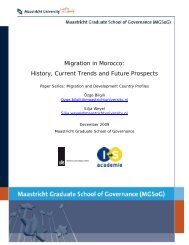Migration in Burundi: History, Current Trends and Future - MGSoG ...
Migration in Burundi: History, Current Trends and Future - MGSoG ...
Migration in Burundi: History, Current Trends and Future - MGSoG ...
Create successful ePaper yourself
Turn your PDF publications into a flip-book with our unique Google optimized e-Paper software.
live <strong>in</strong> the Organisation for Economic Co-operation <strong>and</strong> Development (OECD)<br />
countries, which accounts for 38.6% of the entire highly-skilled workforce <strong>in</strong> <strong>Burundi</strong><br />
(Spaan <strong>and</strong> Moppes, 2006). Others put the figures at 12,482 (Hugo, 2006). The<br />
discrepancies <strong>in</strong> these figures are due to lack of accurate data on the ground <strong>in</strong> <strong>Burundi</strong><br />
but also the absence of precise official estimates <strong>in</strong> countries of residence, which fail to<br />
note the number of highly-skilled undocumented migrants. The prolongation of conflict<br />
<strong>in</strong> some parts of <strong>Burundi</strong> <strong>and</strong> cont<strong>in</strong>ued mistrust between the various groups further<br />
fuels the flight of essential human capital despite that relative calm that has returned to<br />
the country.<br />
In the academic field, poor work<strong>in</strong>g conditions have contributed significantly to<br />
the bra<strong>in</strong> dra<strong>in</strong> of academic staff 37 . In addition to the impact of outward migration,<br />
<strong>in</strong>ternal displacement is also a major migratory dimension <strong>and</strong> pattern that disrupts the<br />
conditions necessary for the development of qualified manpower. The massive<br />
dislocation of <strong>Burundi</strong>an families from villages to urban areas, region to region, <strong>and</strong> <strong>in</strong>to<br />
the border regions has also disrupted local knowledge bases for essential human capital<br />
for subsistence production. It can be concluded that bra<strong>in</strong> dra<strong>in</strong> <strong>in</strong> <strong>Burundi</strong> will have<br />
negative growth effects (Rapoport, 2002), due to the migration rate of its highly educated<br />
as a result of conflict. It will also impact reconstruction efforts due to the absence of<br />
essential human capital <strong>in</strong> a small country like <strong>Burundi</strong>. This is a scenario captured by<br />
Docquier (2006), who observed that bra<strong>in</strong> dra<strong>in</strong> impacts a wide range of features such as<br />
human capital formation, the role of remittances, the impact of return migration, the<br />
effects of diaspora externalities, <strong>and</strong> governance <strong>and</strong> corruption. These are aspects that<br />
confront <strong>Burundi</strong> at a period of transition, when the absence of suitable <strong>in</strong>stitutional<br />
frameworks <strong>and</strong> appropriate migration <strong>and</strong> development policies for attract<strong>in</strong>g the<br />
diaspora could h<strong>in</strong>der the realization of bra<strong>in</strong>-ga<strong>in</strong> efforts (Schiff, 2005).<br />
6.2 Return migration<br />
The return to relative peace after the Arusha Peace Accord has led to an <strong>in</strong>creas<strong>in</strong>g<br />
number of <strong>Burundi</strong>ans <strong>in</strong> the diaspora return<strong>in</strong>g home temporarily, permanently, or as<br />
tourists to help with the reconstruction. This <strong>in</strong>cludes the return <strong>and</strong> re<strong>in</strong>tegration of<br />
<strong>Burundi</strong>an refugees com<strong>in</strong>g from neighbour<strong>in</strong>g countries <strong>and</strong> the <strong>in</strong>ternally displaced<br />
who are currently be<strong>in</strong>g assisted to settle <strong>in</strong> their previous villages <strong>and</strong> homes.<br />
37 For detailed account on the state of higher education <strong>in</strong> <strong>Burundi</strong>, please consult: Juma Shabani, African<br />
Higher Education: An International Reference H<strong>and</strong>book; Damtew Teferra <strong>and</strong> Philip. G. Altbach, eds.,<br />
Indiana University Press, 2003, pp. 204-214.<br />
43



